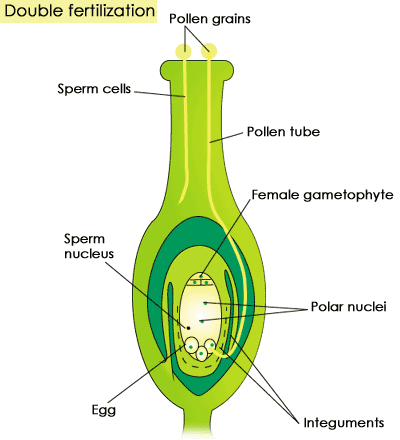Fertilization in plants occurs when haploid gametes meet to create a diploid zygote, which develops into an embryo. In gymnosperms (conifers) and angiosperms (flowering plants), the meeting of the gametes occurs in the following way: male gametes are enclosed in pollen grains and are carried by wind or insects to the female reproductive organs. The final product of fertilization--the embryo--is encased in a seed. For this reason, these two types of tracheophytes are termed seed plants. (See Plant Structures and Functions, The Seed.)
Gymnosperm Fertilization
The female gametophyte contains several archegonia, where the egg cells originate and develop. The gametophyte itself is surrounded by layers of sporangia and integument; all of these elements comprise an ovule, which is found on the surface of a female cone. Fertilization occurs when pollen grains (male gametophytes) are carried by the wind to the open end of an ovule, which contains the eggs, or female gametophyte. There, the pollen grain develops an outgrowth called a pollen tube, which eventually penetrates to the egg cell within one of the archegonia. The sperm cells within the pollen tube then vie to fertilize the egg. Once fertilization has occurred, the embryo develops within the female gametophyte, and the ovule becomes the seed, complete with a food source (the gametophyte tissue) and a seed coat (the integument). This embryo, which will eventually become a new sporophyte, consists of two embryonic leaves, the epicotyl and hypocotyl.
Angiosperm Fertilization
The female reproductive organ of angiosperms is the pistil, located in the
middle of the flower. As in gymnosperms, the male gametophyte is the pollen
grain. In order for fertilization to occur in most flowering plants, insects or
other animals must transport the pollen to the pistil. A major distinguishing
feature of angiosperms is the practice of double fertilization.

In order for fertilization to occur, angiosperms either self-pollinate, in which a particular plant fertilizes itself, or cross-pollinate, in which one plant is fertilized by another of the same species. Cross-pollination generally produces far more vigorous plants, and is encouraged through differential development of the male and female gametophytes on a flower, or through the positioning of these gametophytes so that self- pollination is difficult.













